Fabrication of Micro-Parts with High-Aspect Ratio Micro-Hole Array by Micro-Powder Injection Molding
Abstract
:1. Introduction
2. Experimental Methods
3. Results and Discussion
3.1. Feedstock Characteristics
3.2. Microstructure and Mechanical Properties
3.3. Performance Comparison of the Different Powders
3.4. Formability of Micro-Parts with the High-Aspect Ratio Micro-Hole Array
4. Conclusions
Author Contributions
Funding
Acknowledgments
Conflicts of Interest
References
- Saotome, Y.; Yasuda, K.; Kaga, H. Microdeep drawability of very thin sheet steels. J. Mater. Process. Technol. 2001, 113, 641–642. [Google Scholar] [CrossRef]
- Bauer, W.; Müller, M.; Knitter, R.; Börsting, P.; Albers, A.; Deuchert, M.; Schulze, V. Sign and prototyping of a ceramic micro turbine: A case study. Microsyst. Technol. 2010, 16, 607–615. [Google Scholar] [CrossRef]
- Spearing, S.M. Materials issues in microelectromechanical systems (MEMS). Acta Mater. 2000, 48, 179–196. [Google Scholar] [CrossRef]
- Su, B.; Zhang, Z.Z.; Meng, J.H. Centrifuge-assisted micromolding of ceramic microparts. Ceram. Int. 2014, 40, 13735–13739. [Google Scholar] [CrossRef]
- Sen, M.; Shan, H.S. A review of electrochemical macro- to micro-hole drilling processes. Int. J. Mach. Tool Manuf. 2005, 45, 137–152. [Google Scholar] [CrossRef]
- Zhang, C.H.; Ohmori, H.; Li, W. Small-hole machining of ceramic material with electrolytic interval-dressing (ELID-II) grinding. J. Mater. Process. Technol. 2000, 105, 284–293. [Google Scholar] [CrossRef]
- Hanemann, T.; Honnef, K. Process chain development for the realization of zirconia microparts using composite reaction molding. Ceram. Int. 2009, 35, 269–275. [Google Scholar] [CrossRef]
- Manicone, P.F.; Iommetti, P.R.; Raffaelli, L. An overview of zirconia ceramics: Basic properties and clinical applications. J. Dent. 2007, 35, 819–826. [Google Scholar] [CrossRef] [PubMed]
- Tay, B.Y.; Liu, L.; Loh, N.H.; Tor, S.B.; Murakoshi, Y.; Maedac, R. Surface roughness of microstructured component fabricated by μMIM. Mater. Sci. Eng. A 2005, 396, 311–319. [Google Scholar] [CrossRef]
- Mehregany, M.; Zorman, C.A. SiC MEMS: Opportunities and challenges for applications in harsh environments. Thin Solid Films 1999, 355–356, 518–524. [Google Scholar] [CrossRef]
- Liu, L.; Gao, Y.Y.; Qi, X.T.; Qi, M.X. Effects of wall slip on ZrO2 rheological behavior in micro powder injection molding. Ceram. Int. 2018, 44, 16282–16294. [Google Scholar] [CrossRef]
- Oh, J.W.; Lee, W.S.; Park, S.J. Investigation and modeling of binder removal process in nano/micro bimodal powder injection molding. Int. J. Adv. Manuf. Technol. 2018, 97, 4115–4126. [Google Scholar] [CrossRef]
- He, J.Q.; Shao, Z.J.; Khan, D.F.; Yin, H.Q.; Elder, S.; Zheng, Q.J.; Qu, X.H. Investigation of inhomogeneity in powder injection molding of nano zirconia. Powder Technol. 2018, 328, 207–214. [Google Scholar] [CrossRef]
- Shin, K.; Heo, Y.; Park, H.; Chang, S.; Rhee, B. Development of metal plate with internal structure utilizing the metal injection molding (MIM) process. Materials 2013, 6, 5878–5892. [Google Scholar] [CrossRef] [PubMed]
- Poh, L.; Della, C.; Ying, S.; Goh, C.; Li, Y. Powder distribution on powder injection moulding of ceramic green compacts using thermogravimetric analysis and differential scanning calorimetry. Powder Technol. 2018, 328, 256–263. [Google Scholar] [CrossRef]
- Oh, J.W.; Lee, W.S.; Park, S.J. Nanopowder effect on Fe nano/micro-bimodal powder injection molding. Metall. Mater. Trans. A 2018. [Google Scholar] [CrossRef]
- Sotomayor, M.E.; Várez, A.; Levenfeld, B. Influence of powder particle size distribution on rheological properties of 316 L powder injection moulding feedstocks. Powder Technol. 2010, 200, 30–36. [Google Scholar] [CrossRef]
- Jung, I.D.; Park, J.M.; Yu, J.H.; Kang, T.G.; Kim, S.J.; Park, S.J. Particle size effect on the magneto-rheological behavior of powder injection molding feedstock. Mater. Charact. 2014, 94, 19–25. [Google Scholar] [CrossRef]
- German, R.M. Progress in titanium metal powder injection molding. Materials 2013, 6, 3641–3662. [Google Scholar] [CrossRef] [PubMed]
- Wang, Q.; Yin, H.; Qu, X.H.; Johnson, J.L. Effects of mold dimensions on rheological of feedstock in micro powder injection molding. Powder Technol. 2009, 193, 15–19. [Google Scholar] [CrossRef]
- Park, J.M.; Han, J.S.; Gal, C.W.; Oh, J.W.; Kim, J.H.; Kate, K.H.; Atre, S.V.; Kim, Y.; Park, S.J. Fabrication of micro-sized piezoelectric structure using powder injection molding with separated mold system. Ceram. Int. 2018, 44, 12709–12716. [Google Scholar] [CrossRef]
- Saidin, H.; Azuddin, M. Preparation of aluminum feedstock for green part specimen using metal injection molding. In Applied Mechanics and Materials, Proceedings of 4th International Conference on Mechanical and Manufacturing Engineering (ICME 2013), Bangi Putrajaya, Malaysia, 17–18 December 2013; Ismail, A.E., Nor, N.H.M., Ali, M.F.M., Ahmad, R., Masood, I., Tobi, A.L.M., Ghafir, M.F.A., Muhammad, M., Wahab, M.S., Zain, B.A.M., Eds.; Trans. Tech. Publications Inc.: Zürich, Switzerland, 2014; Volume 465–466, pp. 1250–1254. [Google Scholar]
- Shin, D.S.; Oh, J.W.; Kim, H.J.; Park, S.J. Microstructural and core loss behaviors of addictive Fe-17 at% P based on Fe-3.5 wt% Si alloys in powder injection molding. J. Alloy Compd. 2018, 749, 758–767. [Google Scholar] [CrossRef]
- Lu, Z.; Huang, Z.H.; Jiang, S.S. Influencing factors for the microstructure and mechanical properties of micro porous titanium manufactured by metal injection molding. Metals 2016, 6, 83. [Google Scholar] [CrossRef]
- Wang, C.R.; Xiao, H.; Shao, K.W.; Lu, Z.; Zhang, K.F. Densification and mechanical properties of boron carbide with micro-hole array by micro-powder injection molding. Ceram. Int. 2014, 40, 7915–7921. [Google Scholar] [CrossRef]
- Julie, V.; Anne-Catherine, B.; Elise, C.; Mathieu, L.; Nathalie, T.O.; Maxime, P.; Cyril, M.; Stéphane, V.; Stéphane, B. Factors influencing microinjection molding replication quality. J. Micromech. Microeng. 2018, 28, 015004. [Google Scholar]
- Wang, C.R.; Lu, Z.; Zhang, K.F. Microstructure, mechanical properties and sintering model of B4C nozzle with micro holes by powder injection molding. Powder Technol. 2012, 228, 334–338. [Google Scholar] [CrossRef]
- Thavanayagam, G.; Swan, J.E. Aqueous debinding of polyvinyl butyral based binder system for titanium metal injection moulding. Powder Technol. 2018, 326, 402–410. [Google Scholar] [CrossRef]
- Yan, X.K.; Wang, C.; Xiong, W.; Hou, T.W.; Hao, L.; Tang, D.N. Thermal debinding mass transfer mechanism and dynamics of copper green parts fabricated by an innovative 3D printing method. RSC Adv. 2018, 8, 10355–10360. [Google Scholar] [CrossRef] [Green Version]
- Royer, A.; Barriere, T.; Bienvenu, Y. Influence of supercritical debinding and processing parameters on final properties of injection-moulded Inconel 718. Powder Technol. 2018, 336, 311–317. [Google Scholar] [CrossRef]
- Ani, S.M.; Muchtar, A.; Muhamad, N.; Ghani, J.A. Binder removal via a two-stage debinding process for ceramic injection molding parts. Ceram. Int. 2014, 40, 2819–2824. [Google Scholar] [CrossRef]
- Liu, D.M.; Tseng, W.J. Binder removal from injection moulded zirconia ceramics. Ceram. Int. 1999, 25, 529–534. [Google Scholar] [CrossRef]
- Wang, C.R.; Lu, Z.; Zhang, K.F. Evaluation of thermal debinding of injection-molded boron carbide in an ambient atmosphere. Int. J. Mach. Tool Manuf. 2013, 64, 1751–1757. [Google Scholar] [CrossRef]
- Foudzi, F.M.; Muhamad, N.; Sulong, A.B.; Zakaria, H. Yttria stabilized zirconia formed by micro ceramic injection molding: Rheological properties and debinding effects on the sintered part. Ceram. Int. 2013, 39, 2665–2674. [Google Scholar] [CrossRef]
- Ni, J.Q.; Yu, M.H.; Han, K.Q. Debinding and sintering of an injection-moulded hypereutectic Al-Si alloy. Materials 2018, 11, 807. [Google Scholar] [CrossRef] [PubMed]
- Sahli, M.; Djoudi, H.; Gelin, J.C.; Barriere, T.; Assou, M. Correction to: Numerical simulation and experimental analysis of the sintered micro-parts using the powder injection molding process. Microsyst. Technol. 2018, 24, 1509. [Google Scholar] [CrossRef]
- Heaney, D.F.; Spina, R. Numerical analysis of debinding and sintering of MIM parts. J. Mater. Process. Technol. 2007, 191, 385–389. [Google Scholar] [CrossRef]
- Somasundram, I.M.; Cendrowicz, A.; Johns, M.L.; Prajapati, B.; Wilson, D.I. 2-D simulation of wick debinding for ceramic parts in close proximity. Chem. Eng. Sci. 2010, 65, 5990–6000. [Google Scholar] [CrossRef]
- Wang, M.; Ai, X.; Zhao, J. The effect of sintering additives on ceramic material sintering densification process based on cellular automata model. Comp. Mater. Sci. 2014, 90, 16–22. [Google Scholar]
- Yu, P.C.; Li, Q.F.; Fuh, J.Y.H.; Li, T.; Ho, P.W. Micro injection molding of micro gear using nano-sized zirconia powder. Microsyst. Technol. 2009, 15, 401–406. [Google Scholar] [CrossRef]
- Yu, P.C.; Li, Q.F.; Fuh, J.Y.H.; Li, T.; Lu, L. Two-stagesintering of nano-sized yttriastabilized zirconia process by powder injection moulding. J. Mater. Process. Technol. 2007, 192–193, 312–318. [Google Scholar] [CrossRef]
- Piotter, V.; Mueller, T.; Plewa, K.; Prokop, J.; Ritzhaupt-Kleissl, H.J.; Hausselt, J. Manufacturing of complex-shaped ceramic components by micropowder injection molding. Int. J. Mach. Tool Manuf. 2010, 46, 131–134. [Google Scholar] [CrossRef]
- Gietzelt, T.; Jacobi, O.; Piotter, V.; Ruprecht, R.; Hausselt, J. Development of a micro annular gear pump by micro powder injection molding. J. Mater. Sci. 2004, 39, 2113–2119. [Google Scholar] [CrossRef]
- Royer, A.; Barrière, T.; Gelin, J.C. Development and characterization of a metal injection molding bio sourced inconel 718 feedstockbased on polyhydroxyalkanoates. Metals 2016, 6, 89. [Google Scholar] [CrossRef]
- Liu, L.; Loh, N.H.; Tay, B.Y.; Tor, S.B.; Yin, H.Q.; Qu, X.H. Preparation and characterization of micro components fabricated by micro powder injection molding. Mater. Charact. 2011, 62, 615–620. [Google Scholar] [CrossRef]
- Chen, R.H.; Ho, C.H.; Fan, H.C. Shrinkage properties of ceramic injection moulding part with a step-contracted cross-section in the filling direction. Ceram. Int. 2004, 30, 991–996. [Google Scholar] [CrossRef]
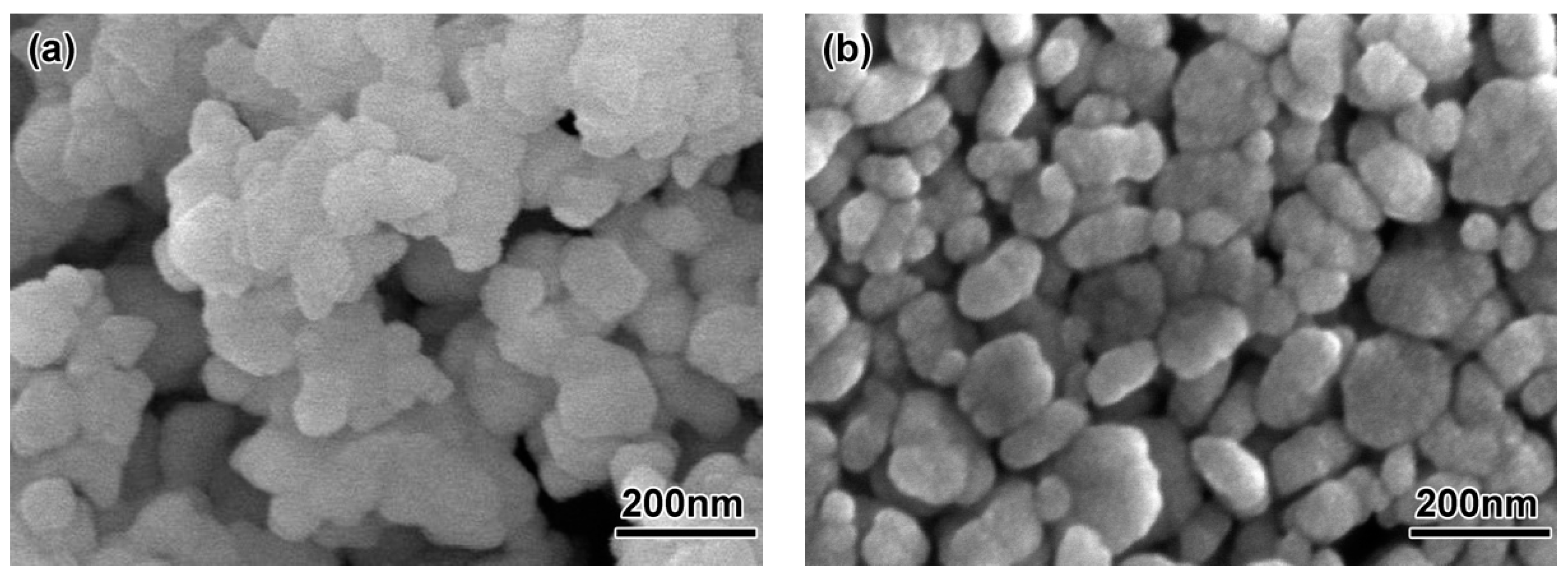



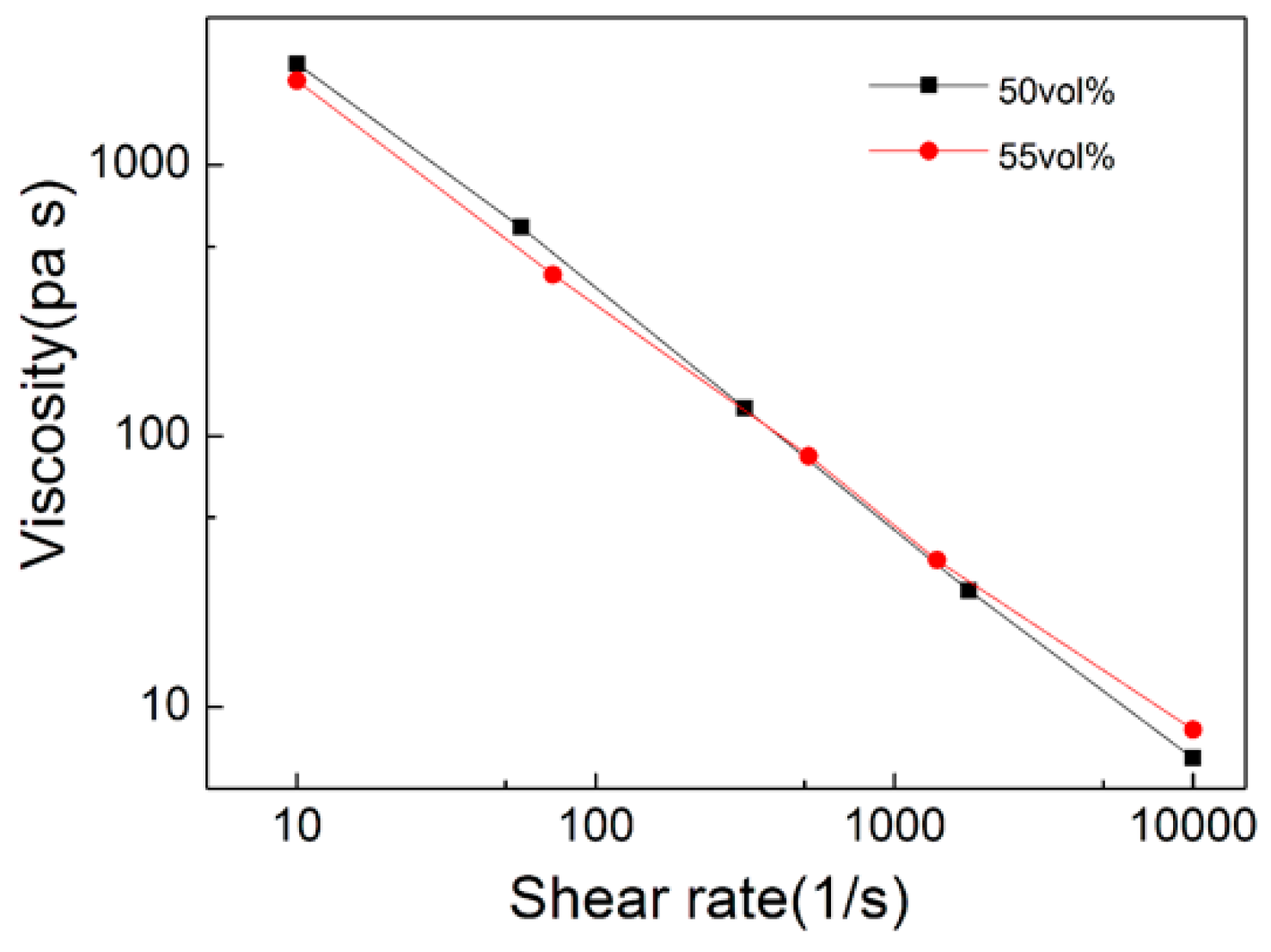

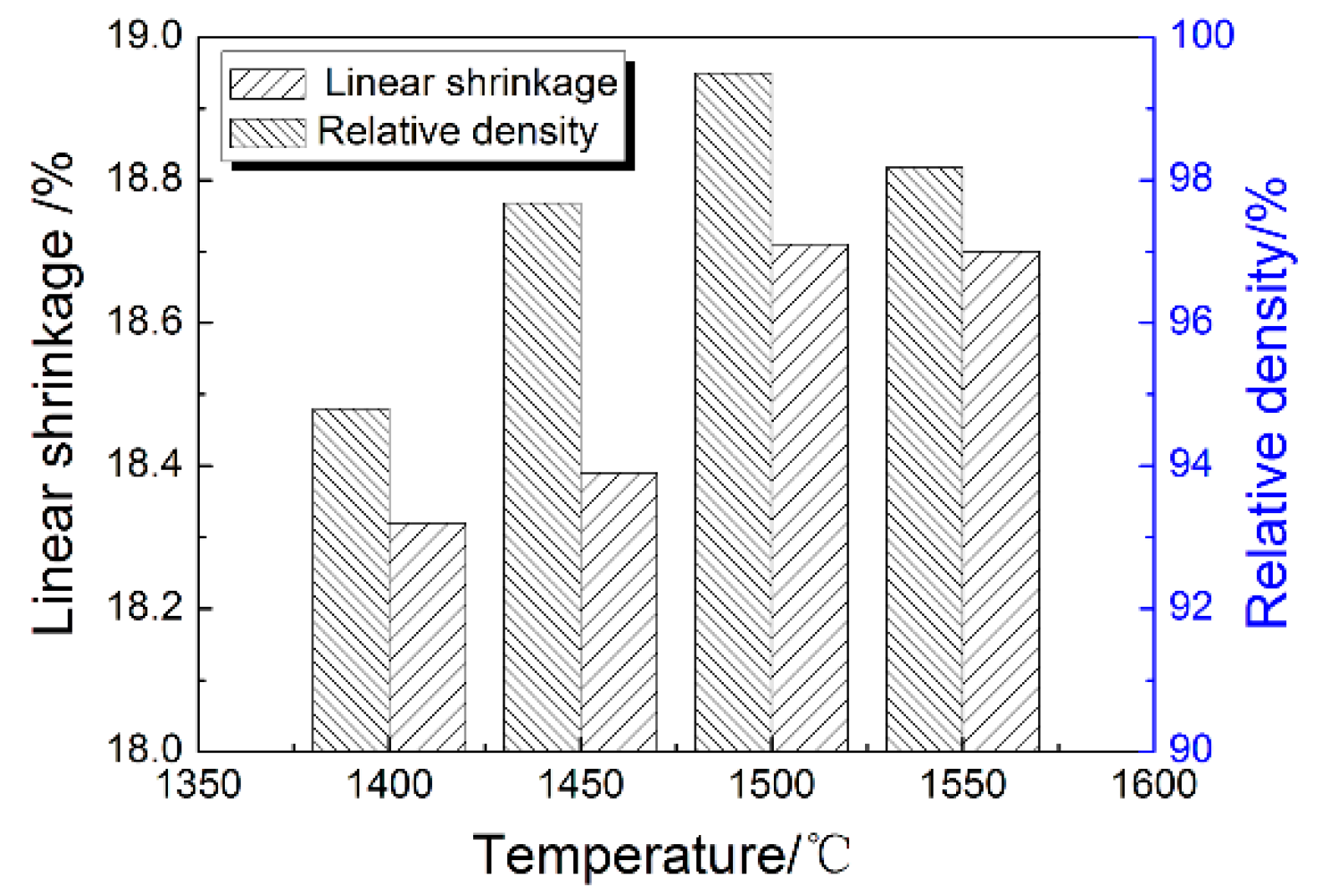

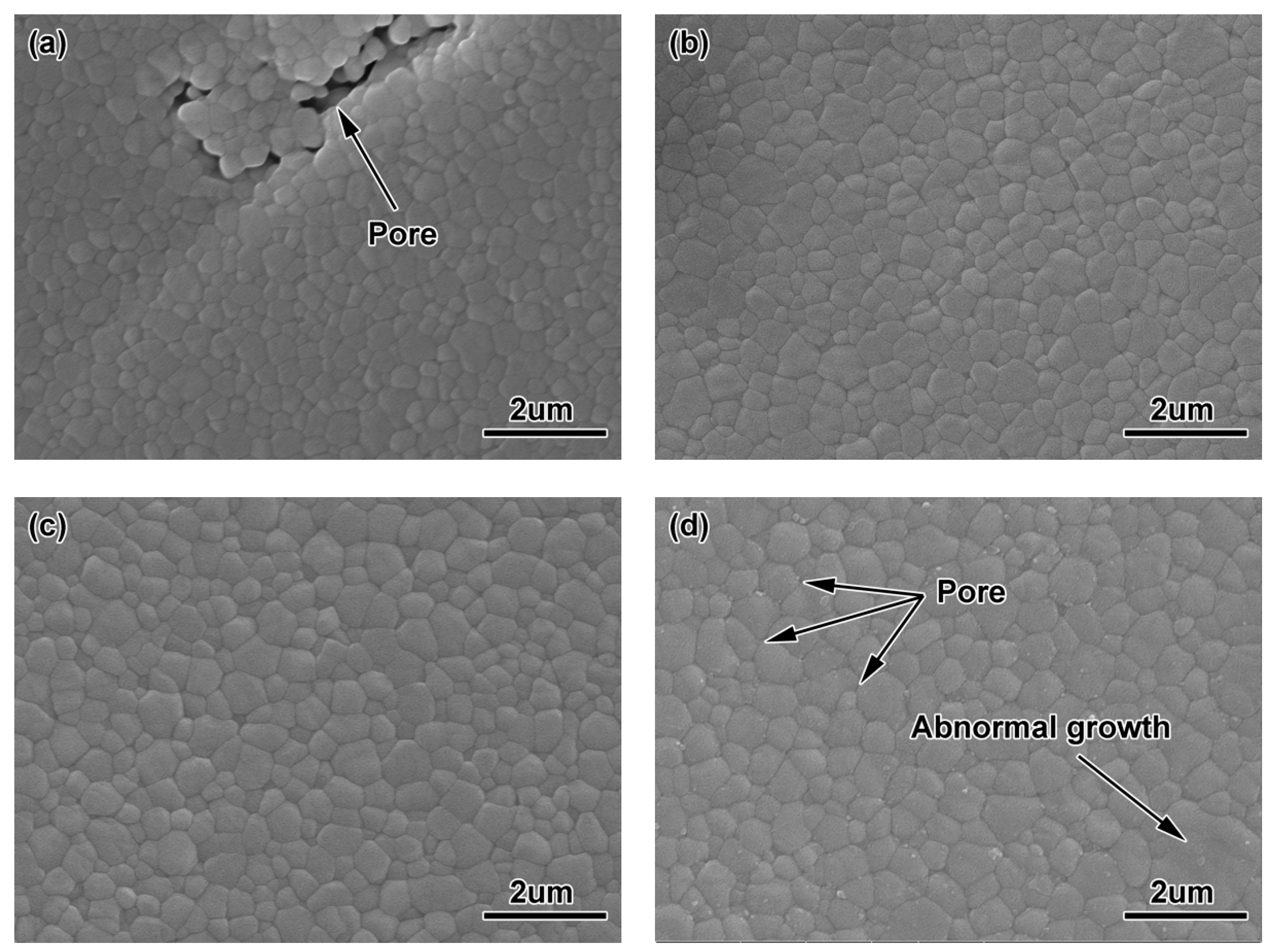

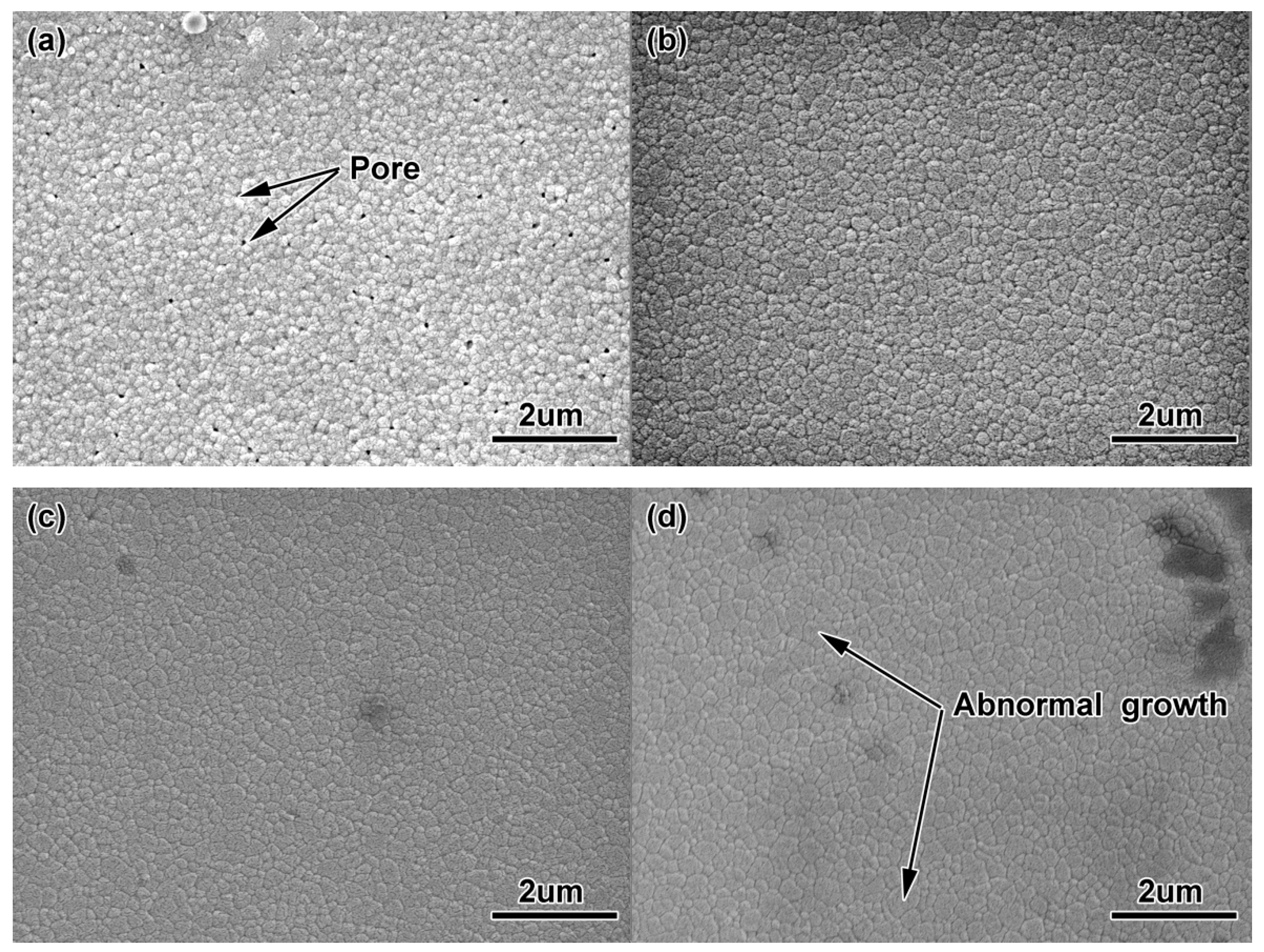
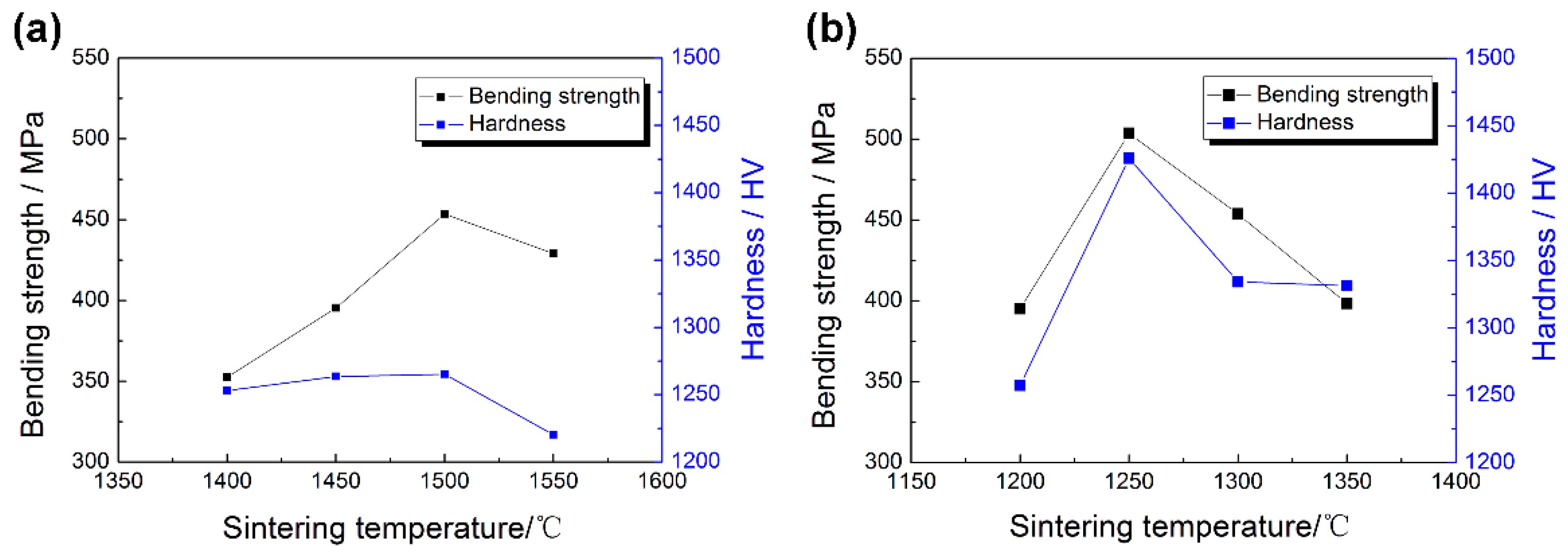
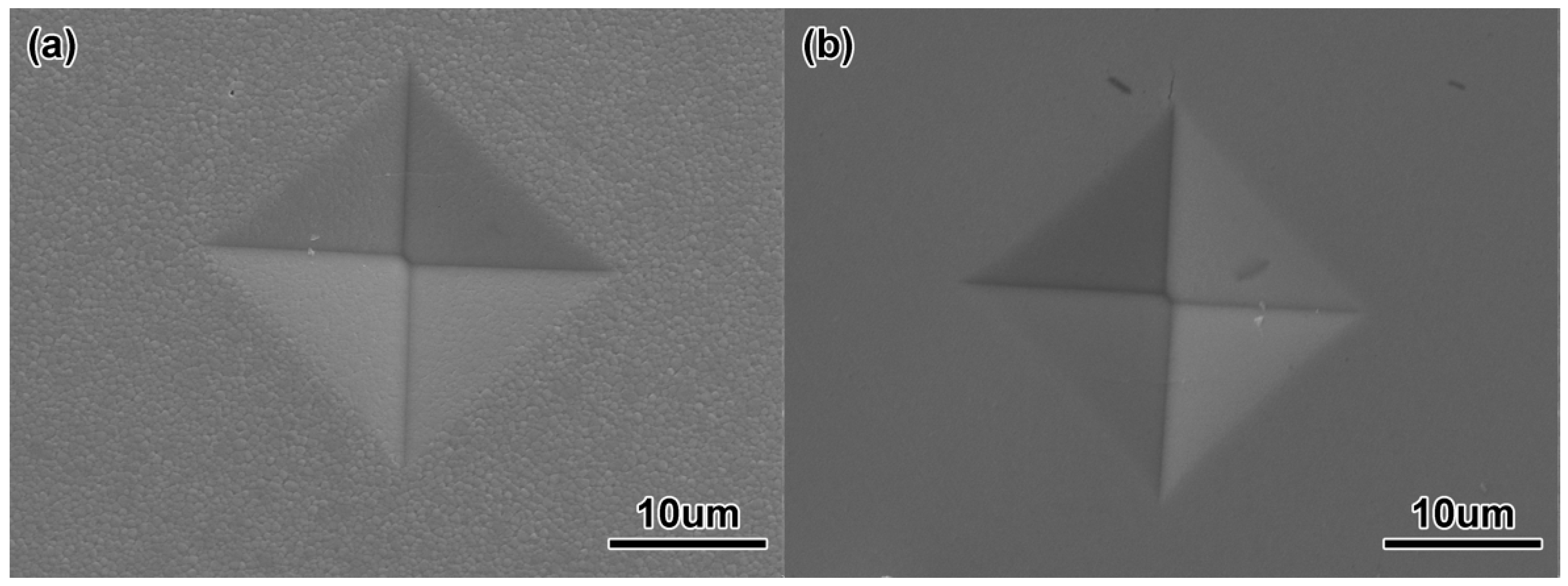


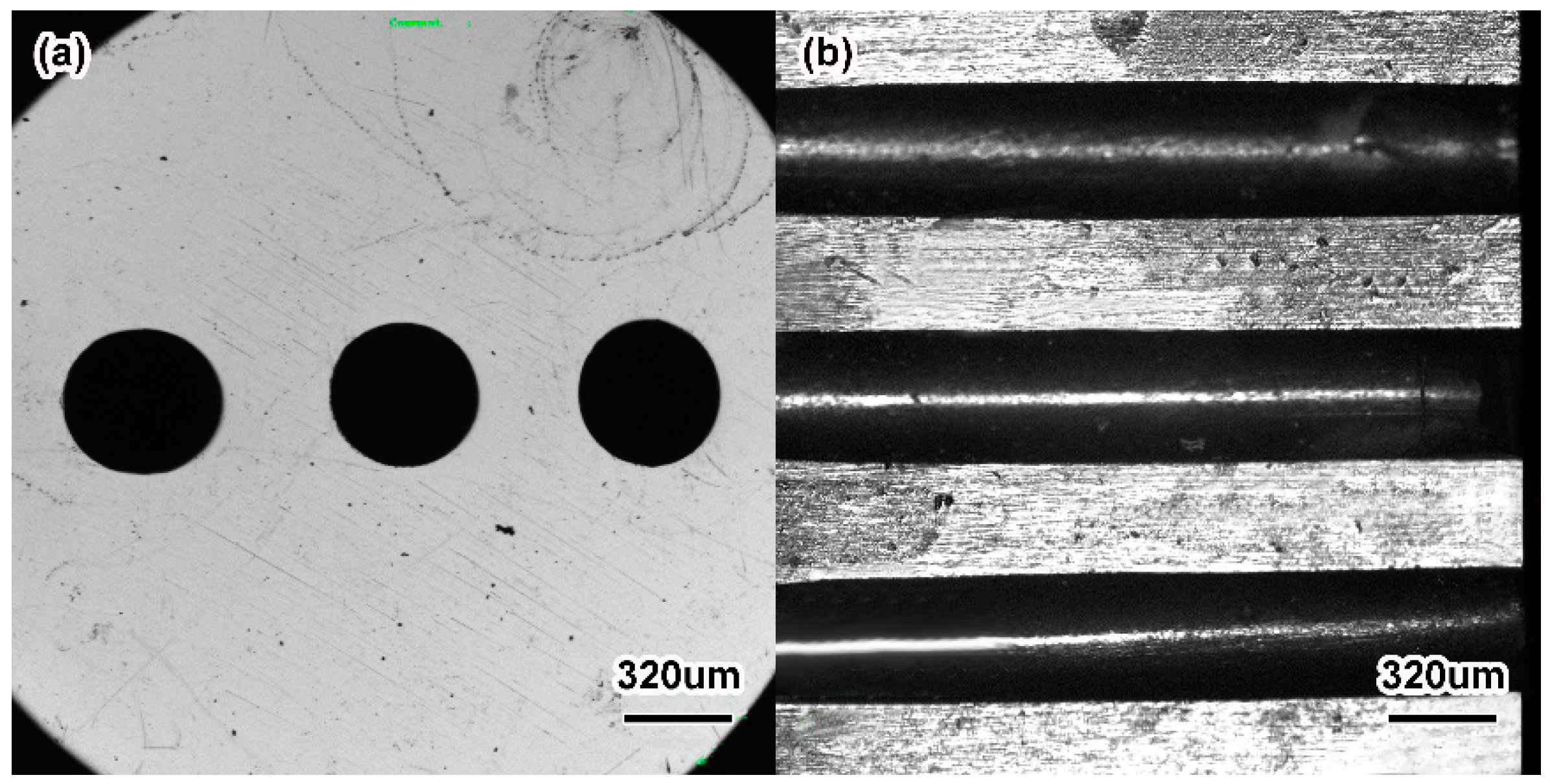
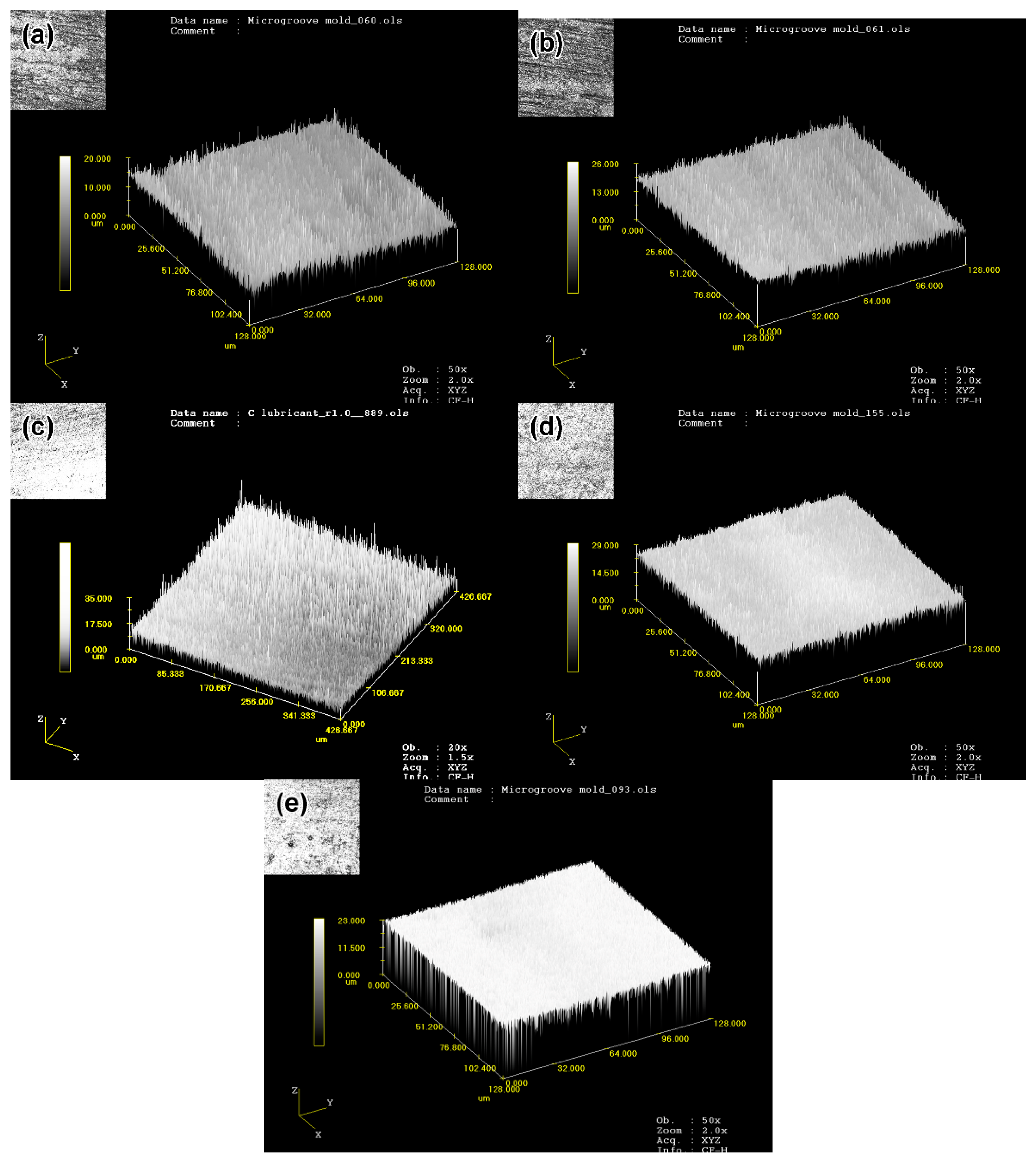
| Y2O3 | Al2O3 | SiO2 | Fe2O3 | MgO | CaO | TiO2 | Na2O |
|---|---|---|---|---|---|---|---|
| 3 | ≤0.005 | ≤0.005 | ≤0.003 | ≤0.003 | ≤0.003 | ≤0.001 | ≤0.001 |
| Samples | Particle Size (nm) | 1 | 2 | 3 | 4 | 5 | 6 | Average Value | Average Deviation |
|---|---|---|---|---|---|---|---|---|---|
| Value | 200 | −0.1 | −0.07 | −0.04 | −0.11 | −0.06 | −0.08 | −0.077 | −2% |
| 100 | −0.25 | −0.23 | −0.27 | −0.26 | −0.25 | −0.26 | −0.25 | −7.1% |
| Samples | Particle Size (nm) | Flexural Strength (MPa) | Linear Shrinkage (%) |
|---|---|---|---|
| Molded | 200 | 11.3 | - |
| 100 | 9.66 | - | |
| Debinded | 200 | 6.78 | 1.45 |
| 100 | 11.10 | 1.78 |
| Samples | Particle Size (nm) | Flexural Strength (MPa) | Linear Shrinkage (%) | Density (%) |
|---|---|---|---|---|
| Molded | 200 | 11.3 | - | - |
| 100 | 9.66 | - | - | |
| Debinded | 200 | 6.78 | 1.45 | - |
| 100 | 11.10 | 1.78 | - | |
| Sintered | 200 | 453.4 (max) | 18.04 (max) | 99.5 (max) |
| 100 | 503.6 (max) | 20.52 (max) | 98.36 (max) |
| Relative Density (%) | Linear Shrinkage | ||
|---|---|---|---|
| Nozzle | Micro-Hole | Wall of Two Adjacent Holes | |
| 99.5 | 18.04 | 15.3 | 21.4 |
© 2018 by the authors. Licensee MDPI, Basel, Switzerland. This article is an open access article distributed under the terms and conditions of the Creative Commons Attribution (CC BY) license (http://creativecommons.org/licenses/by/4.0/).
Share and Cite
Wang, C.; Lu, Z.; Zhang, K. Fabrication of Micro-Parts with High-Aspect Ratio Micro-Hole Array by Micro-Powder Injection Molding. Materials 2018, 11, 1864. https://doi.org/10.3390/ma11101864
Wang C, Lu Z, Zhang K. Fabrication of Micro-Parts with High-Aspect Ratio Micro-Hole Array by Micro-Powder Injection Molding. Materials. 2018; 11(10):1864. https://doi.org/10.3390/ma11101864
Chicago/Turabian StyleWang, Changrui, Zhen Lu, and Kaifeng Zhang. 2018. "Fabrication of Micro-Parts with High-Aspect Ratio Micro-Hole Array by Micro-Powder Injection Molding" Materials 11, no. 10: 1864. https://doi.org/10.3390/ma11101864




